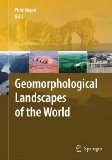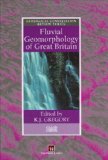
|
Geomorphological Landscapes of the World
Physical landscapes are one of the most fascinating facets of our Planet, which tell stories about the evolution of the surface of the Earth. This book provides up-to-date information about the geomorphology of the selected ‘classic’ sites from around the world and shows the variety of geomorphological landscapes as moulded by different sets of processes acting over different timescales, from millions of years to days. The volume is written by nearly fifty geomorphologists from more than twenty countries who for many years have researched some of the unique sceneries on the planet. The thirty six chapters present each continent of the world. They describe landscapes of different origin, so that the reader can learn about the complexity of processes behind the sceneries. This is a useful reference book, linking geomorphology with global initiatives focused on nature conservation. |
|
Mapping Geomorphological Environments
Mapping Geomorphological Environments is a highly descriptive textbook providing an excellent introduction to the latest methodologies for mapping geomorphological formations in a variety of different environments. Its holistic approach seeks to provide a meaningful linkage between state of the art techniques for geomorphological mapping, including the latest innovations in geospatial applications, and advances in the understanding of the formation of geomorphological phenomena in a variety of settings and environments. The book includes: - An introduction to the processes which form geomorphological formations and how to map them. - Case studies from a variety of environments with many examples of geomorphological maps. - In-depth descriptions of the latest tools and methodologies such as field sampling, GPS usage, 3–4D mapping, GIS analysis, digital image analysis, etc. - A list of the geomorphological characteristics per environment (e.g. coastal, fluvial, etc.) in the format of a geomorphological encyclopaedia, with pictures, maps and symbols. It covers the entire workflow ranging from data collection, analysis, interpretation, and mapping. Acknowledgements All authors would like to acknowledge the contribution of Dr. John W.M. Peterson, School of Computing Sciences, University of East Anglia, Norwich, UK, for corrections and improvement to the English text.. Università Telematica Guglielmo Marconi (UTGM) and ENEA acknowledge the collaboration of CUTGANA (Centro Universitario per la Tutela e la Gestione degli Ambienti Naturali e degli Agroecosistemi), Università di Catania, for the paper on "The Cyclops Islands". IRMCo acknowledges the use of the Integrated Land and Water Information System (ILWIS), developed by ITC, the Netherlands, for the management and assessment of geographic information in a GIS environment. ILWIS functionality was employed for the paper on "The natural heritage of the Island of Gozo" and the paper on "The geomorphological cave features of Ghar il-Friefet". IPB (Polytechnic Institute of Bragança) wishes to acknowledges all those colleagues, most of them also members of CIMO (Centre for Mountain Research), that contributed to the recently issued Management Plan of Montesinho Natural Park (PNM). Their hidden contribution to the articles concerning PNM is much acknowledged. A word in recognition of his endless and contagious enthusiasm towards Montesinho and to the Mountain domain, spread among us all in the IPB, is due to Professor Dionísio Gonçalves, the first Director, Coordinator and President of PNM, CIMO and IPB, respectively. The authors of the photos inserted in the articles concerning Montesinho are also much acknowledged for their contribution. |




